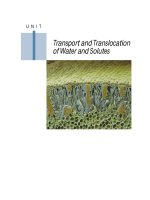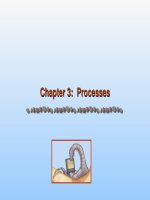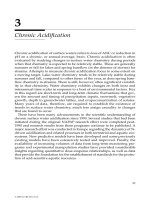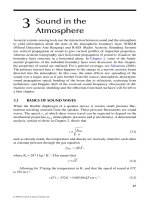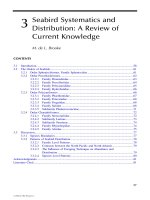Chapter 3 7digestion metabolism
Bạn đang xem bản rút gọn của tài liệu. Xem và tải ngay bản đầy đủ của tài liệu tại đây (4.5 MB, 142 trang )
Digestion & Absorption &
Transport and Metabolism
of Nutrients
Digestion
• The process of physically &
chemically changing the
composition of food in the
gastrointestinal tract
• The process by which food is broken
down into absorbable units
Absorption
• The process of assimilating the
products of DIGESTION into the
body.
Absorption
Anatomy of Absorption
Anatomy of Absorption
• Folds in the small intestinal wall
• Villus - fingerlike projections on the
folds
• Microvilli - hair like projections on
each cell of the small intestine
• Increases the surface area
Vessels in the Villi
• Capillaries in the villi
– carry water soluble nutrients to
liver
– amino acids
– monosaccharides
Vessels in the Villi
• Capillaries in the villi
– water soluble vitamins
– minerals
– water
– glycerol
Vessels in the Villi
• Lymph vessels in the villi
– carry fat soluble nutrients
– triglycerides
– fat soluble vitamins
– cholesterol
Small intestine - villi
Enzymes
• Are very specific for
– substrate
– environment
• temperature
• pH
Enzymes
• Are complex protein molecules
• Enable a chemical reaction to take
place but do not change during the
reaction
Digestive or gastrointestinal system
Esophagus
The Muscular Action of
Digestion
• Peristalsis
• Segmentation
Peristalsis
• Gastrointestinal(GI) tract muscular
• Movement of food/chyme through
the GI tract
• Food moves ahead of the
constriction
Stomach Muscles
The Muscular Action of
Digestion
pH Changes in GI Tract
•
•
•
•
7 = neutral
14 = very basic
1 = very acid
Major changes
– between esophagus and stomach
– between stomach and small
intestine
pH
of
Common
Substances
pH Changes in GI Tract
• Neutral pH in mouth & esophagus
• Stomach pH is very acid
– Inactivates some salivary enzymes
– Activates some enzymes
– Bacterioside
• Shift back to neutral in the small
intestine
Metabolism
• Occurs within individual cells
• It includes the use of basic nutrients
for the work of the cell & chemical
changes are involved
• Building new compounds
• Breaking down compounds
THE CELL
Inside the cell membrane lies the
cytoplasm
Nucleus.
Inside the nucleus are
the chromosomes,
that contain the
genetic material DNA.
The Mitochondria (power houses)
house all the enzymes involved in
the conversion of pyruvate to
acetyl CoA, fatty acid oxidation,
the TCA cycle, and the electron
transport chain.b
The cell membrane
encloses each cell’s
contents and regulates
the passage of molecules
in and out of the cell.
The ribosomes
assemble AA into
proteins.
Metabolism
• Work of the cell includes:
– Anabolism: building new compounds
– Catabolism: breaking down compounds for
energy
Anabolism



